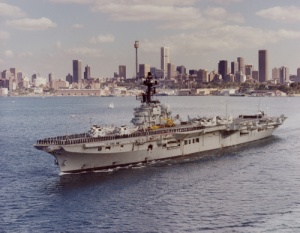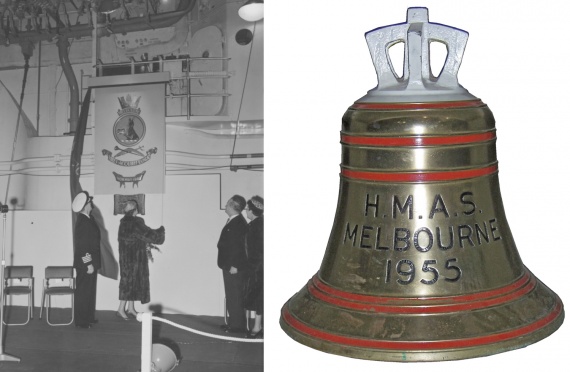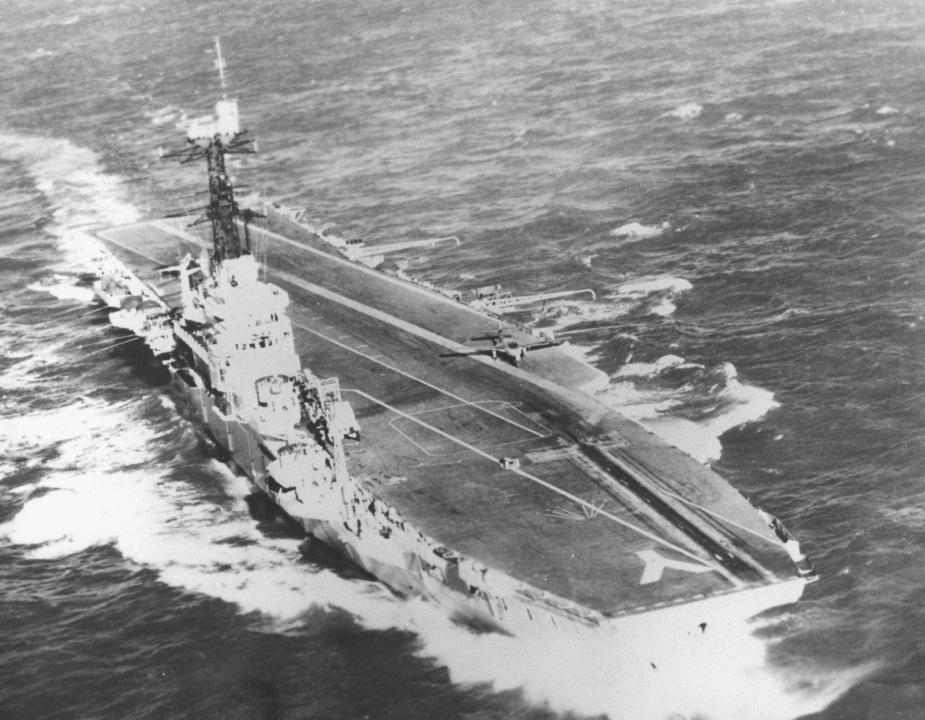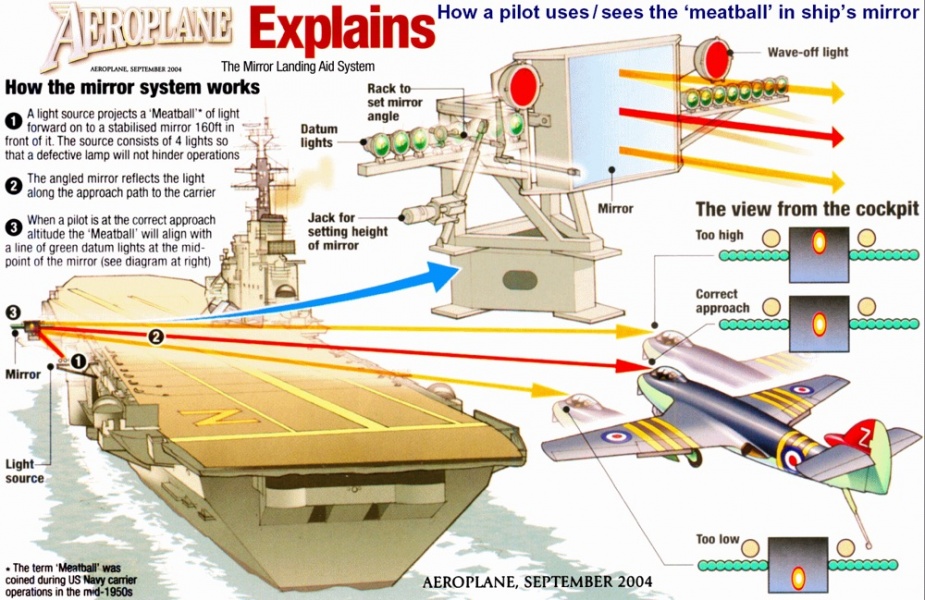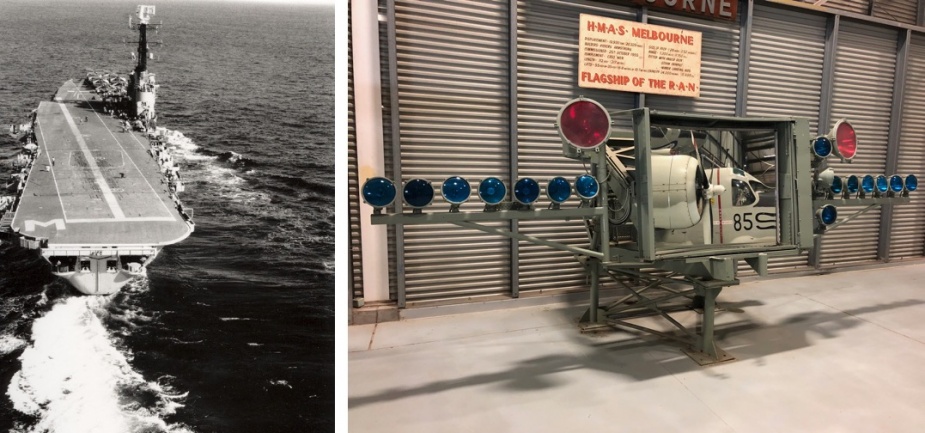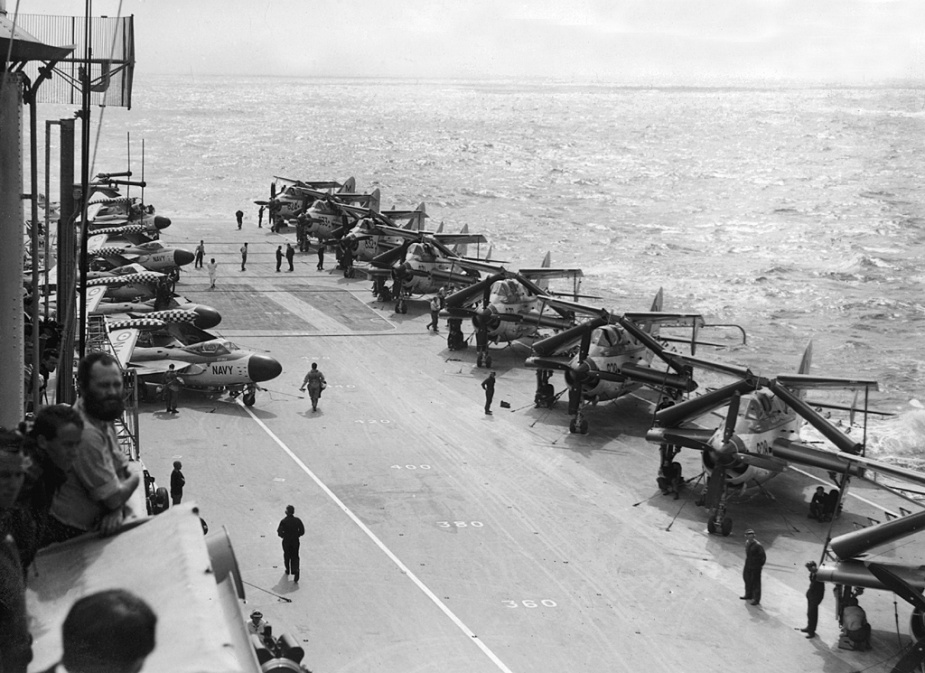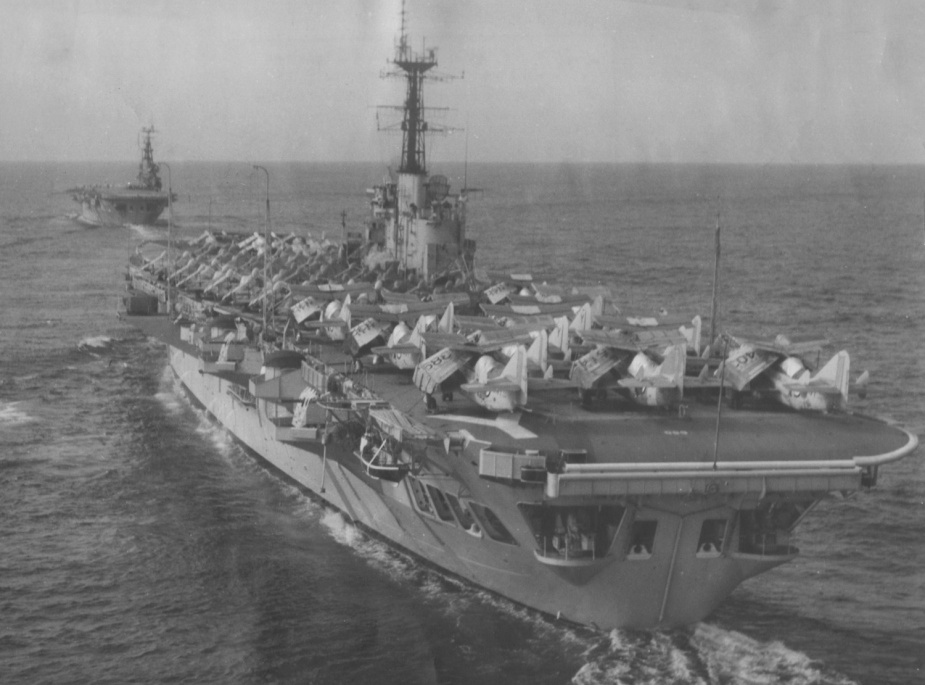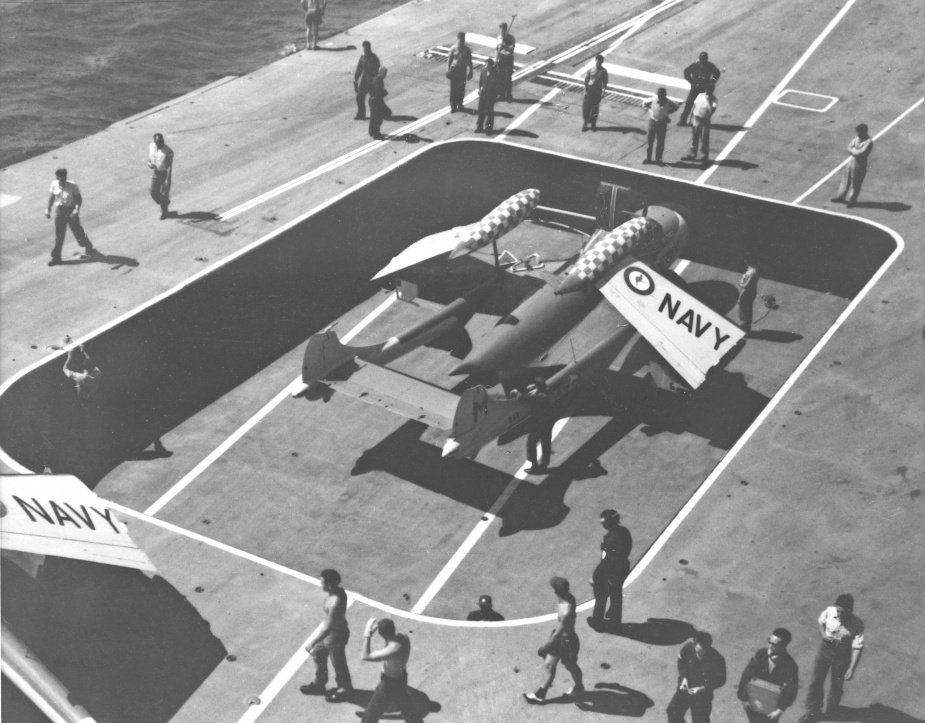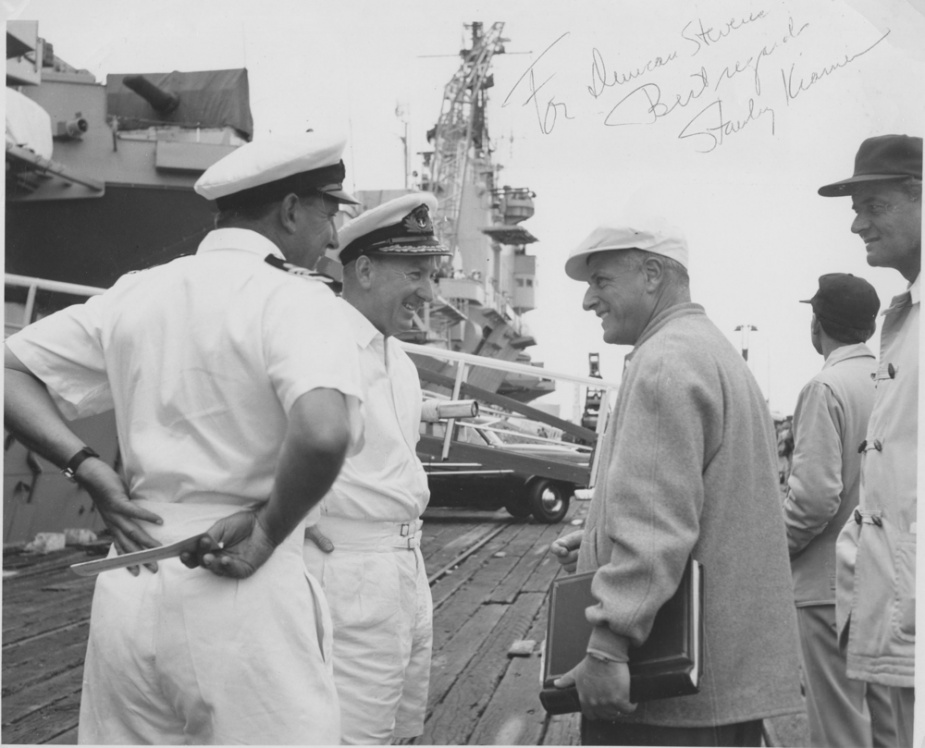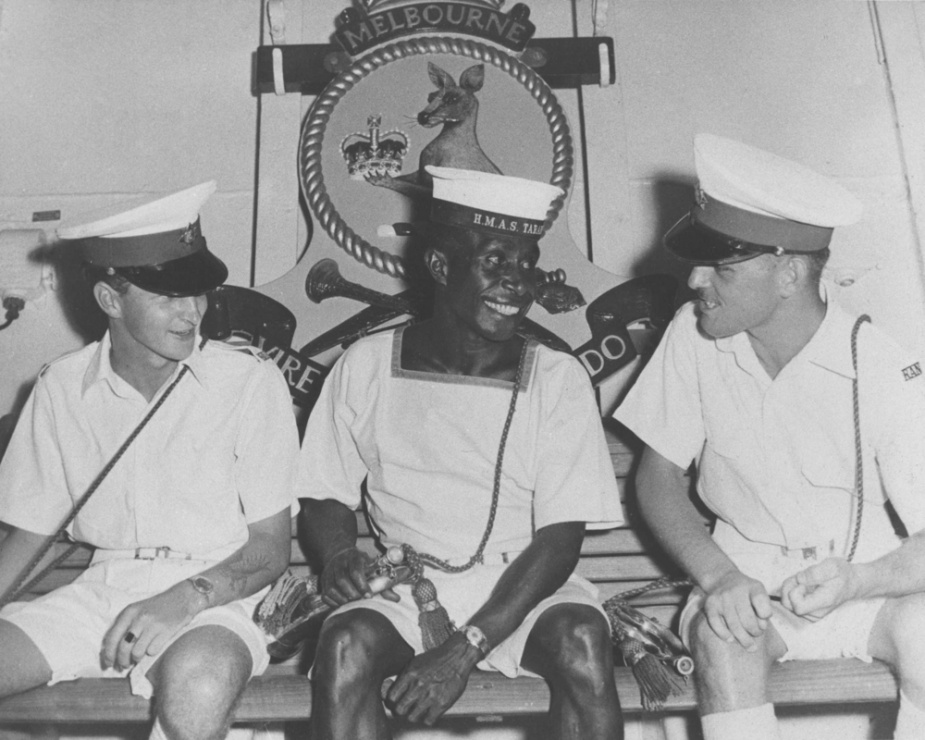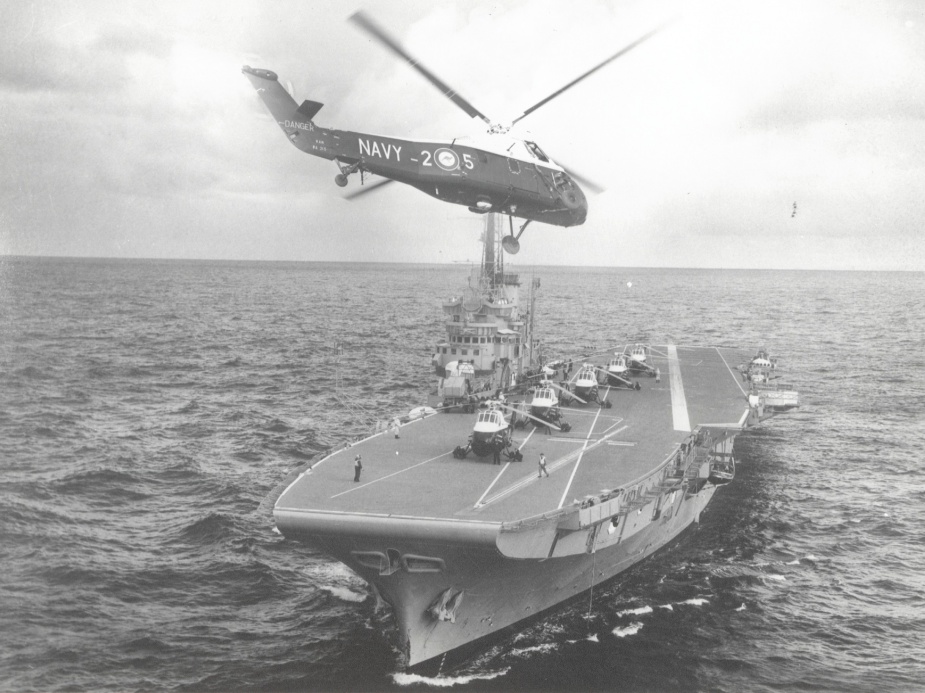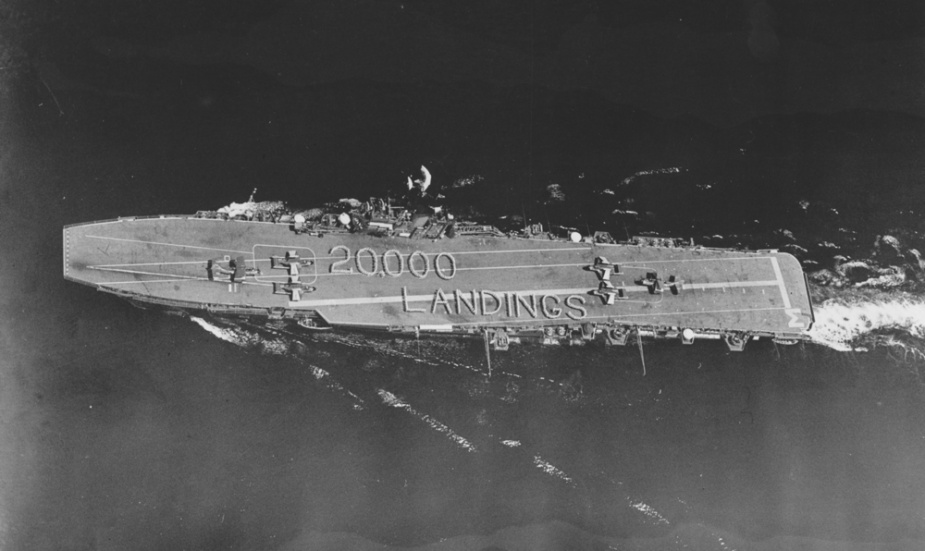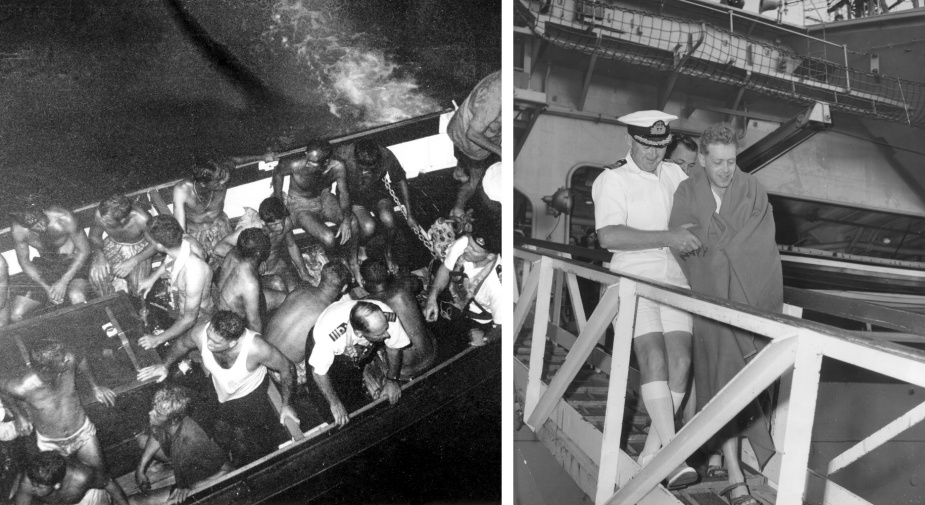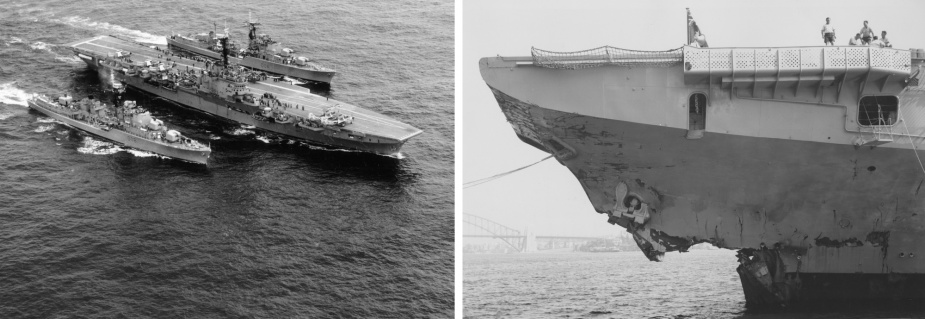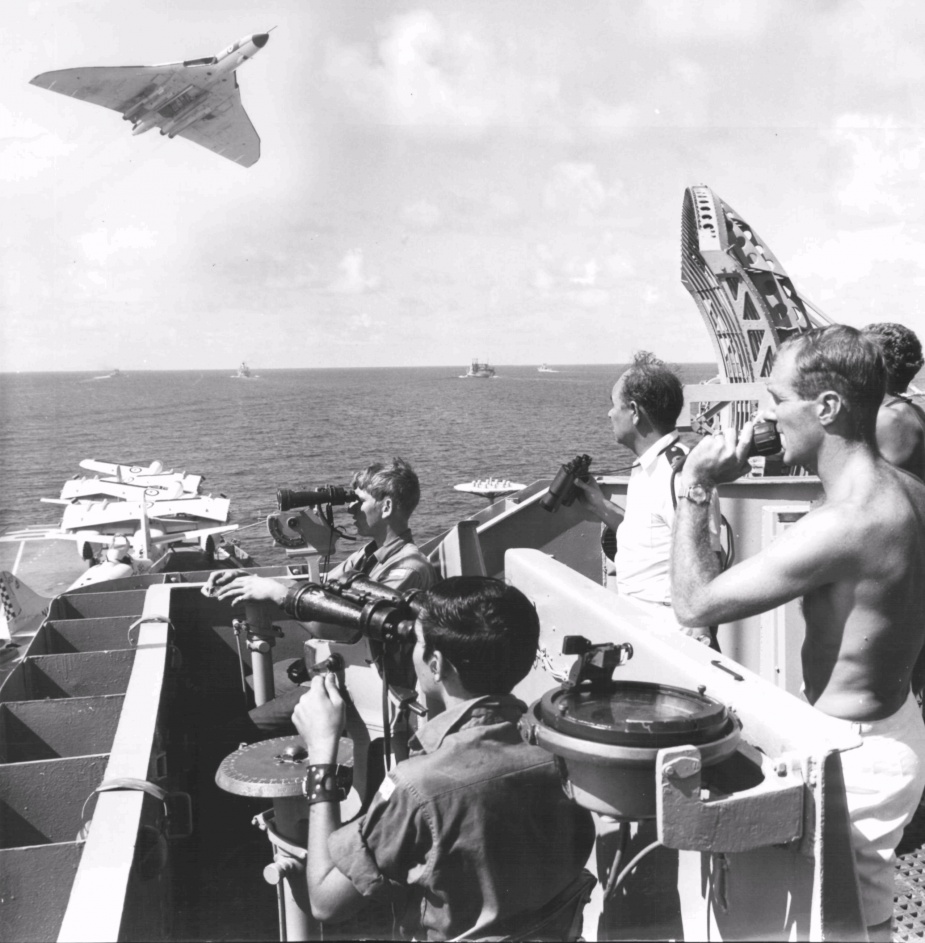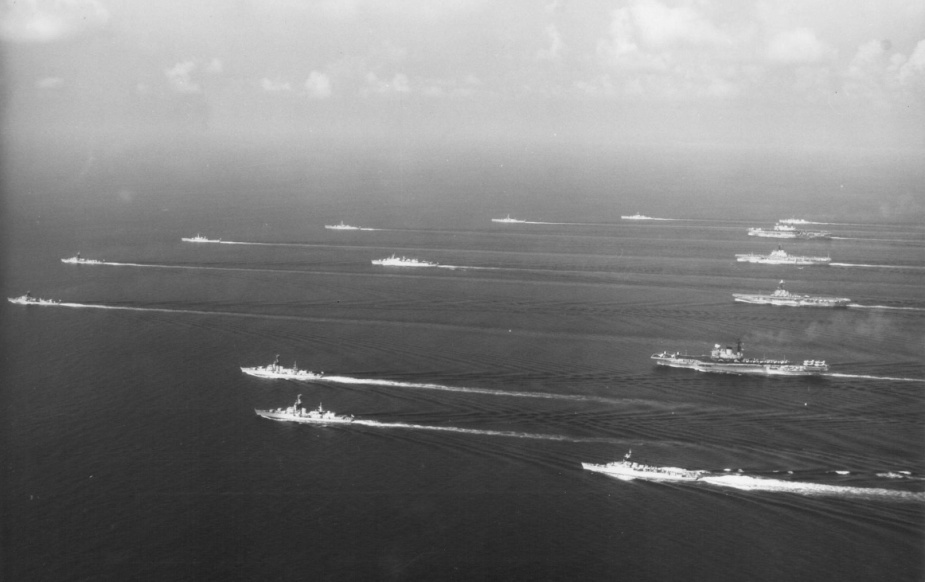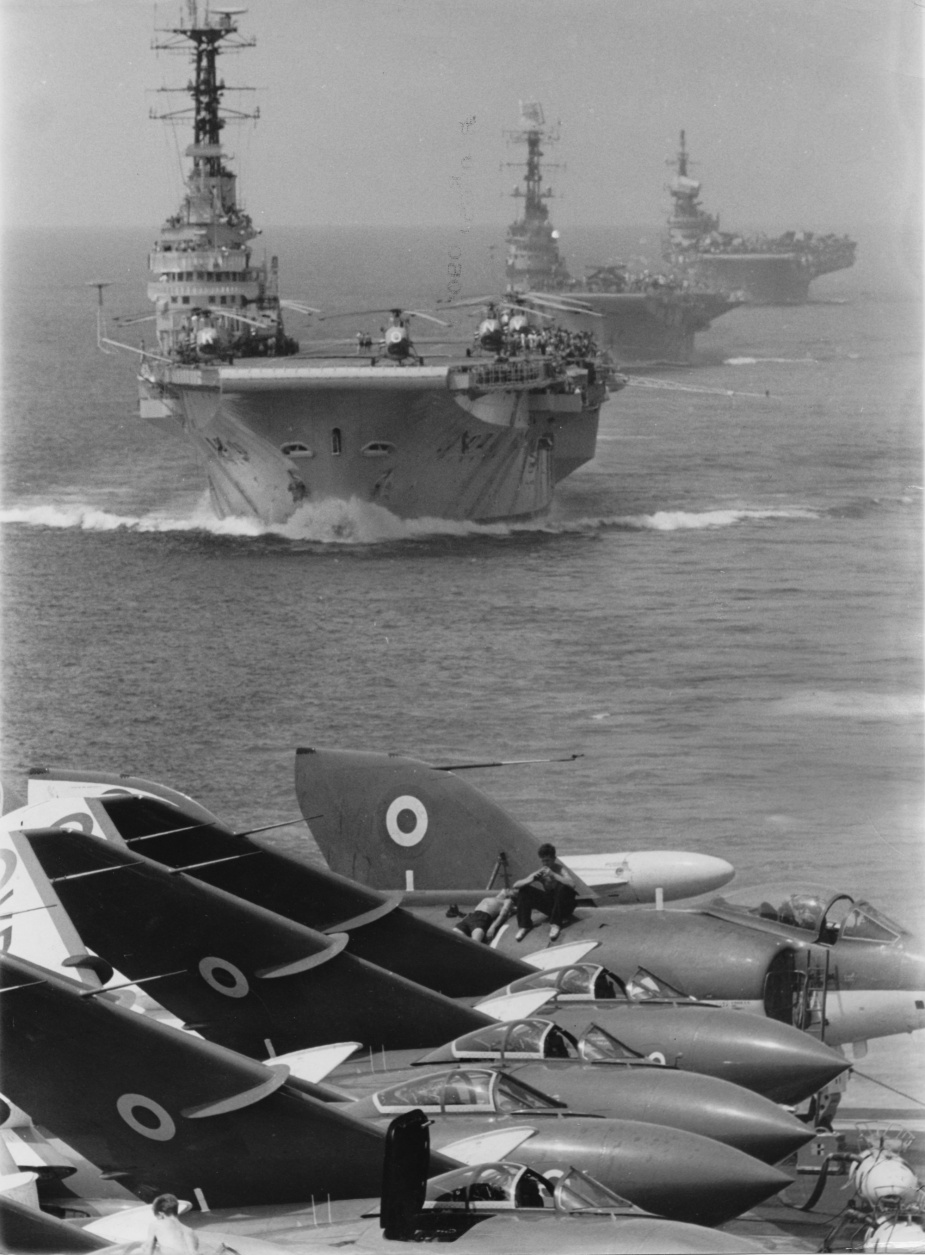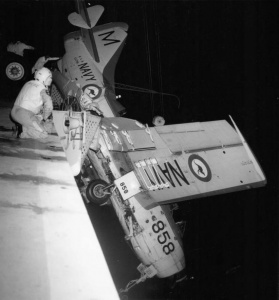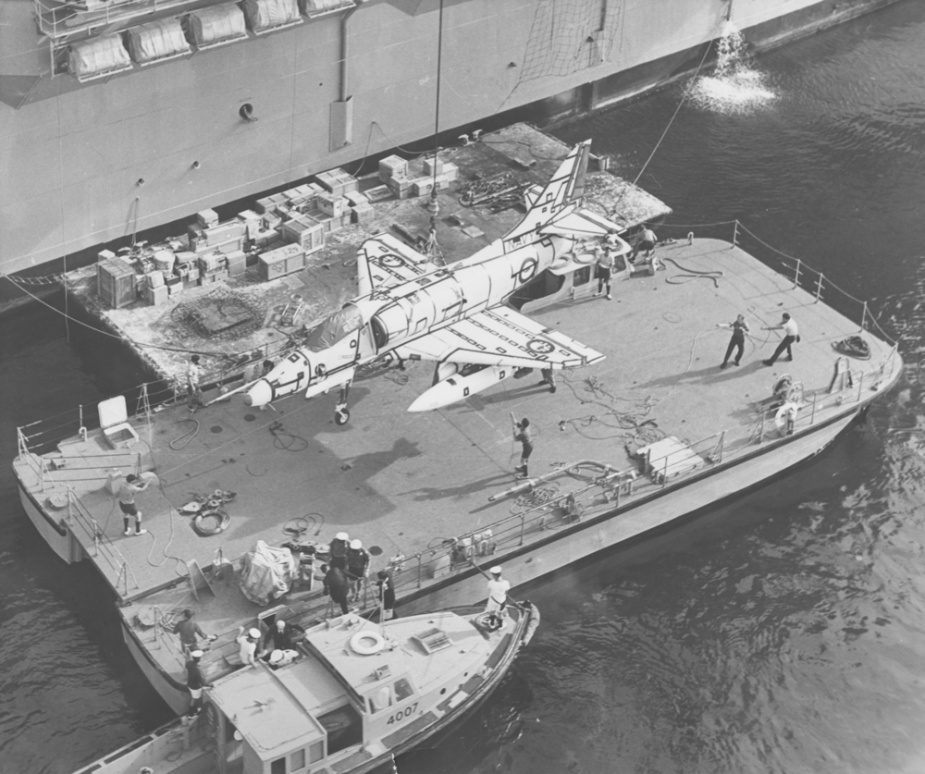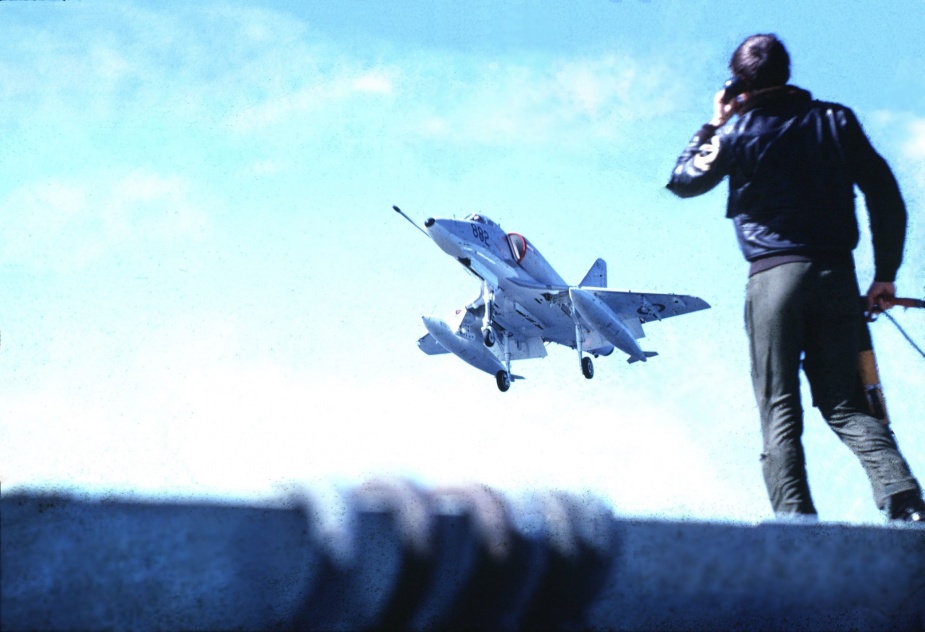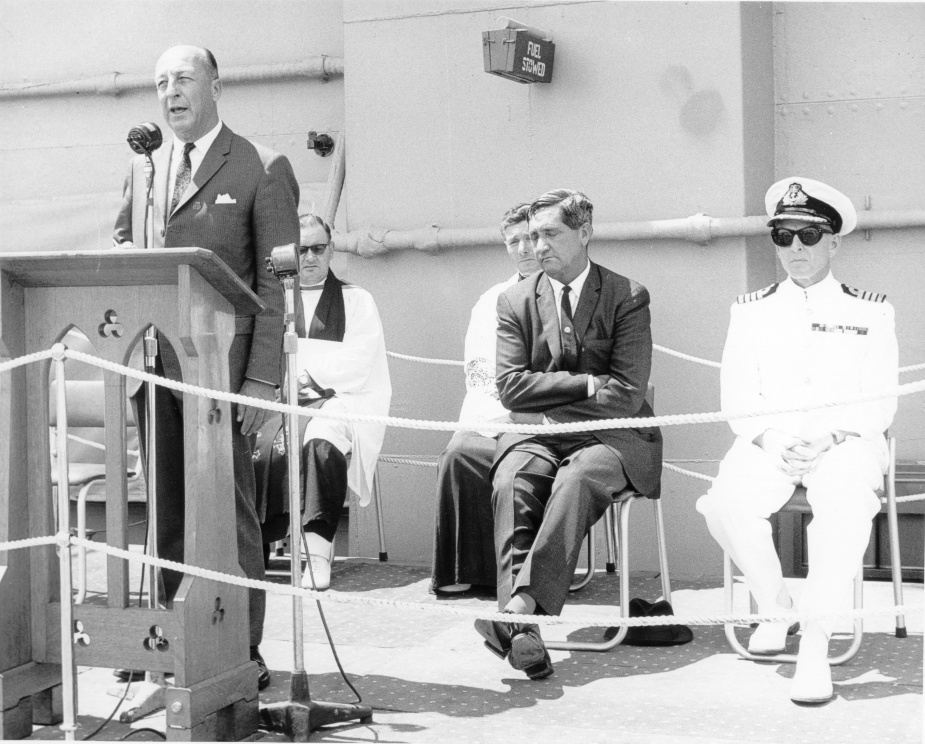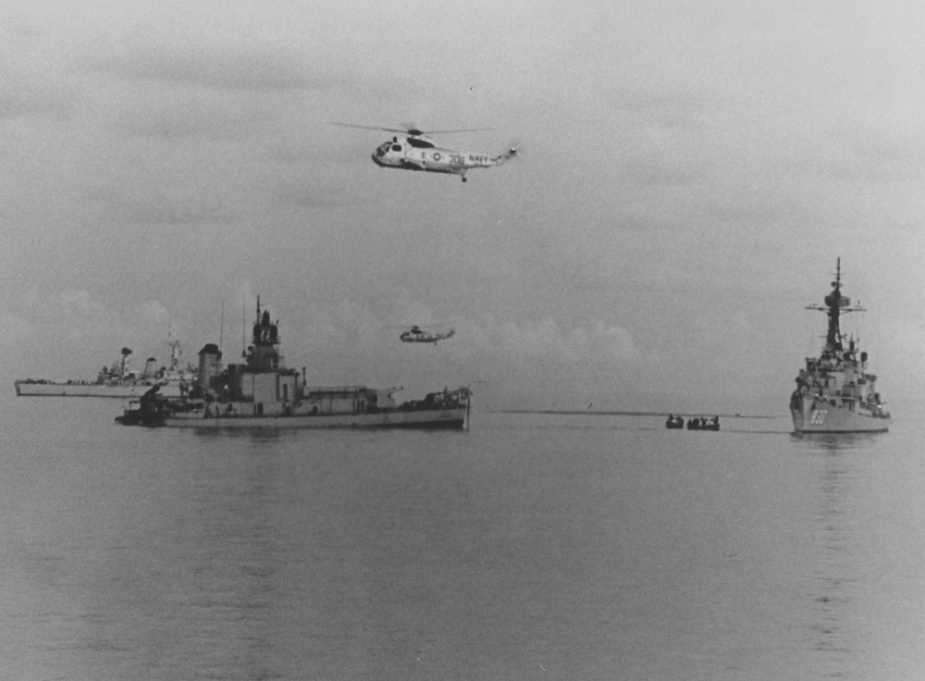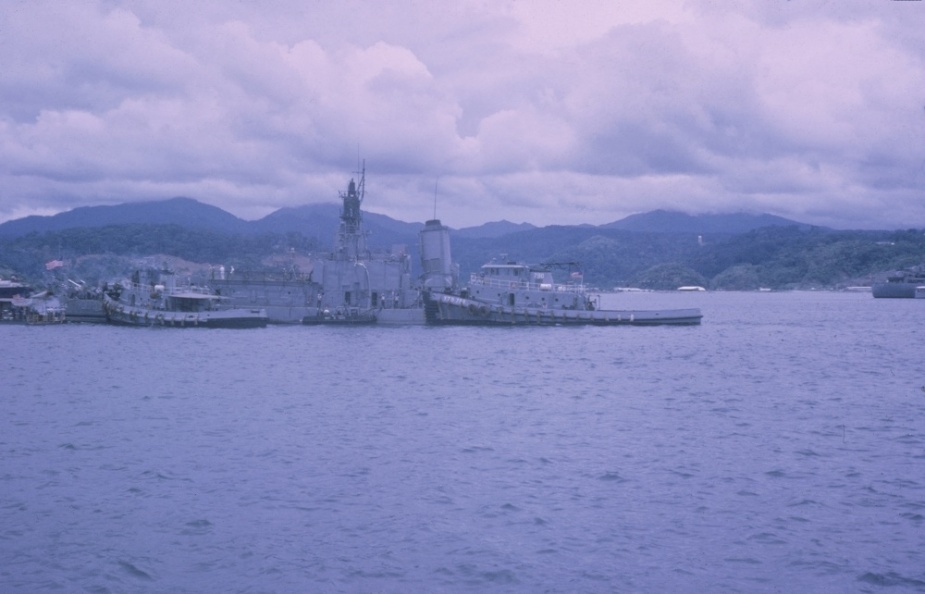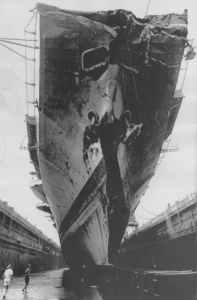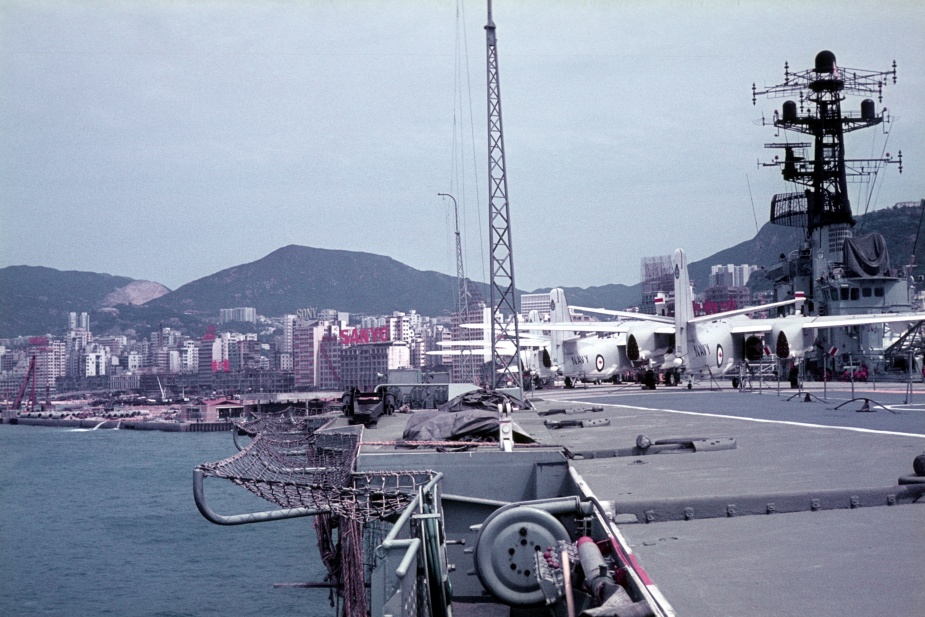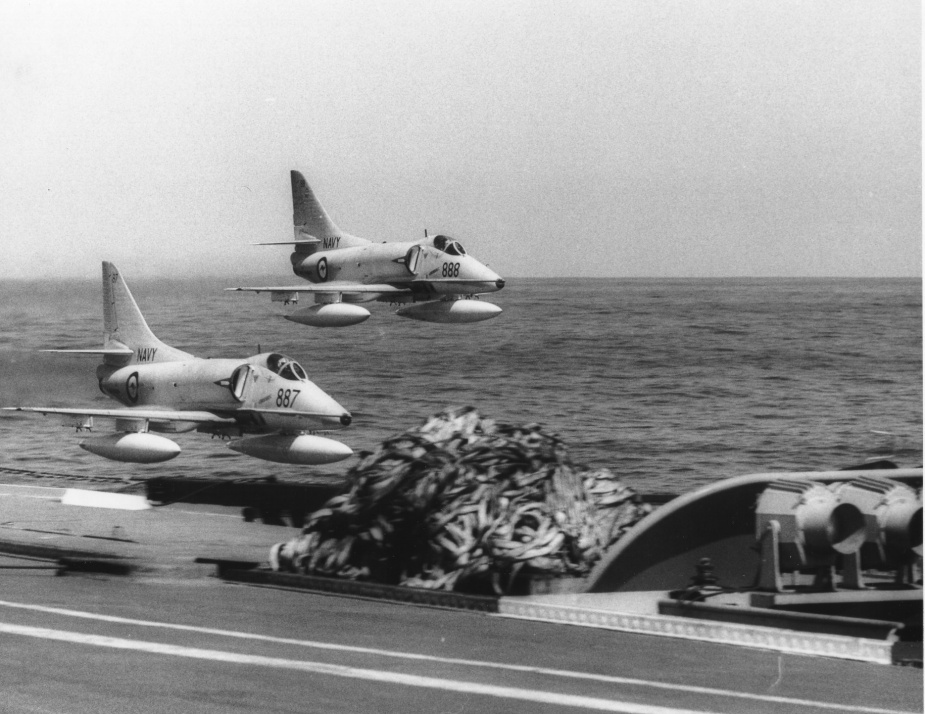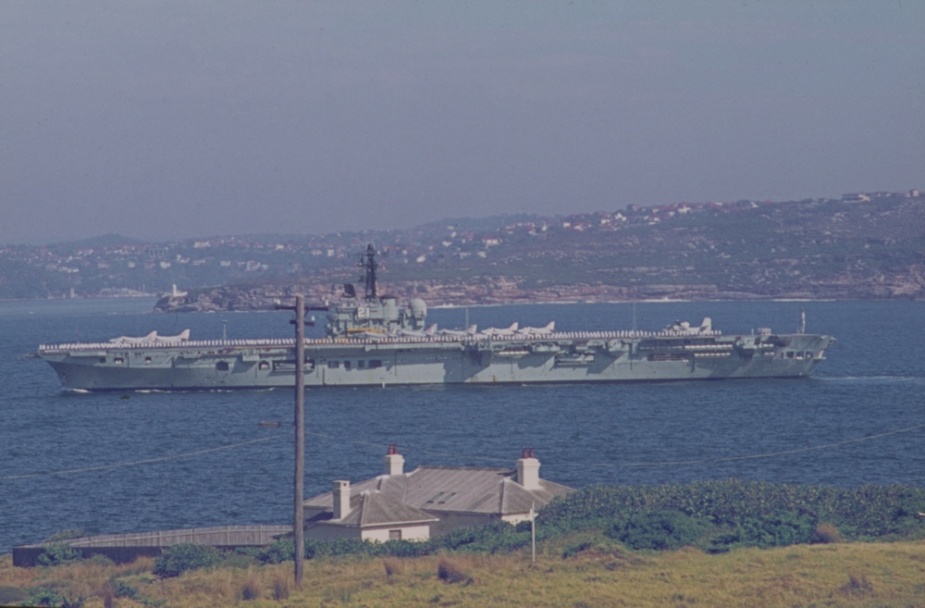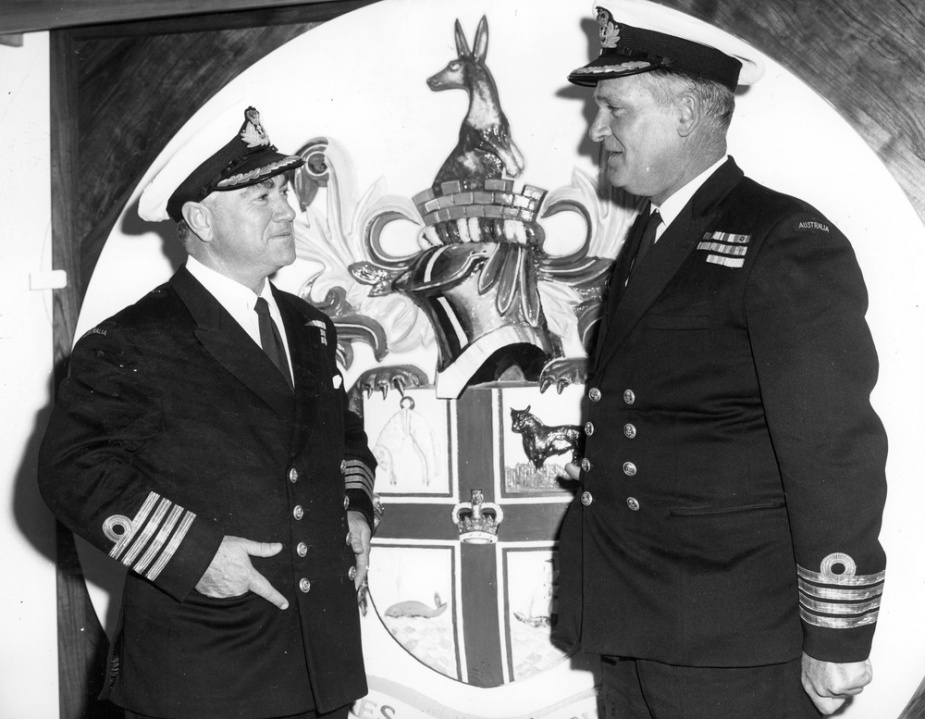HMAS Melbourne (II)
| Class |
Modified Majestic Class |
|---|---|
| Type |
Light Fleet Aircraft Carrier |
| Pennant |
R21 |
| Builder |
Vickers Armstrong Ltd, Barrow-in-Furness, England |
| Laid Down |
15 April 1943 |
| Launched |
28 February 1945 |
| Launched by |
Lady Anderson, wife of the Chancellor of the Exchequer |
| Commissioned |
28 October 1955 |
| Decommissioned |
30 June 1982 |
| Fate |
Sold for scrap |
| Dimensions & Displacement | |
| Displacement |
|
| Length | 701 feet 5 inches (overall) |
| Beam | 80 feet 2 inches |
| Draught | 25 feet 5 inches |
| Flight Deck | 690 feet 8 inches |
| Performance | |
| Speed | 24 knots |
| Range | 12,000 at 14 knots |
| Complement | |
| Crew | 1355 (includes 347 Carrier Air Group personnel) |
| Propulsion | |
| Machinery | Parsons single reduction geared turbines, 2 shafts |
| Horsepower | 42,000 |
| Armament | |
| Guns | 25 x 40mm Bofors anti-aircraft guns |
| Helicopters |
|
| Other Aircraft |
|
| Awards | |
| Inherited Battle Honours | |
| Battle Honours | MALAYSIA 1964-66 |
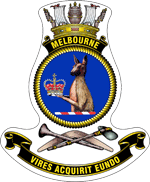
HMAS Melbourne was originally one of six Majestic Class light fleet aircraft carriers ordered for the Royal Navy (RN) during World War II.
Laid down for the RN as HMS Majestic on 15 April 1943 and launched in 1945, the ship was nearing completion when construction was virtually brought to a halt with the cessation of wartime hostilities. Work progressed slowly thereafter and many lessons learnt during the war regarding carrier design and operations were incorporated into the ship's modernisation programme.
In April 1946 the RAN received prime ministerial permission to investigate the establishment of a naval Fleet Air Arm along British lines. The RN retained ten partially completed aircraft carriers, including the six Majestics, from suspended wartime programs. A small team of RAN officers developed a detailed plan for the acquisition of two of these vessels along with two Carrier Air Groups (CAGs) and the establishment of a naval air station.
On 3 June 1947 the Commonwealth Government approved the acquisition of two aircraft carriers for the RAN. It was decided that two of the Majestic Class, HM Ships Terrible and Majestic, would be taken over by the RAN and named Sydney (III) and Melbourne (II) respectively. On 15 August 1947 the Government approved the creation of the Naval (later Fleet) Air Arm.
Post-war technological developments saw a rapid evolution in naval aviation driven primarily by the advent of jet propulsion. These larger and more dynamic jet aircraft led to commensurate advancements in the designs of the carriers from which they operated, most significantly the introduction of angled flight decks, mirror deck landing systems and steam powered catapults. While the construction of the RAN's first carrier, HMAS Sydney (III), was too advanced to include these modifications, the construction of Melbourne was still at an early enough stage for their inclusion.
Work resumed on Melbourne in 1949 at which time it was decided to increase the size of the flight deck lifts to accommodate the larger aircraft coming into service. In 1952, a modified angled flight deck of 5½ degrees was added as was a steam catapult and mirror deck-landing system.
On 28 October, 1955, the ship was officially named and commissioned into the RAN as HMAS Melbourne under the command of Captain Galfrey GO Gatacre, DSO, DSC, RAN, while Lady White, wife of Sir Thomas White, the then Australian High Commissioner in the United Kingdom, performed the naming ceremony.
The first aircraft to touch down on Melbourne's flight deck was a Westland Whirlwind helicopter of the Royal Navy on 6 December 1955. Not long afterwards the first fixed wing aircraft, a Hawker De Havilland Sea Venom and a Fairey Gannet, arrived during trials in the English Channel. Following acceptance and work-up trials in the United Kingdom, Melbourne sailed from Glasgow for Australia on 11 March 1956 with 808 Squadron (Sea Venom all weather fighters) and 816 and 817 Squadrons (Gannet anti-submarine aircraft) embarked.
Her voyage to Australia was by way of the Mediterranean Sea and included visits to Gibraltar, Naples and Malta before transiting through the Suez Canal. On 10 April she visited Colombo before crossing the Indian Ocean and arriving in her first Australian port, Fremantle, on 23 April 1956. Melbourne received a warm and colourful reception in Western Australia and there was great media interest in her arrival. In her captain's first television and press interviews much was made of the revelation that Melbourne possessed the ability to operate her jet aircraft by night as well as by day. This gave Australia a capability at that time not possessed by any land based air force operating jet aircraft in the region.
The Great Australian Bight lived up to its reputation as a rough sea with Melbourne enduring a heavy swell during her passage east for a four day visit to her namesake city, Melbourne. Here the new aircraft carrier was again warmly greeted and a civic reception was held in honour of the occasion at the Melbourne Town Hall.
The final leg of her voyage ‘home’ was via Jervis Bay where the 64 aircraft that Melbourne had brought from the UK were transferred ashore via lighter for road transport to the Naval Air Station at Nowra. Finally on 9 May she arrived in Sydney for the first time. Thousands of people turned out to watch her arrive in the harbour and three days later she replaced HMAS Sydney (III) as the flagship of the RAN when Rear Admiral HM Burrell ‘broke’ his flag in her.
Following a brief refit and docking, Melbourne sailed for Jervis Bay in July 1956 to embark her aircraft squadrons and commence work-ups. She then sailed for Brisbane and the Hervey Bay area to conduct flying training. En route, on 2 August, she participated in the search for survivors from the collier Birchgrove Park which had foundered north of Port Jackson the previous night resulting in the loss of ten lives. Melbourne was released from the search later in the day.
On 8 August tragedy struck Melbourne when Lieutenants Barry Thompson and Keith Potts of 808 Squadron were both killed when their Sea Venom crashed into the sea off Hervey Bay shortly after take off. The aircraft was seen to take off normally but quickly veered to the right and down into the water. The cause of the accident was never discovered although insufficient wind speed over the deck appears to be the most likely reason.
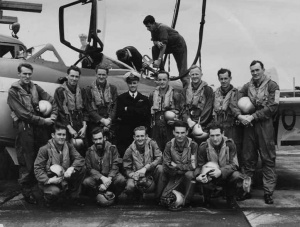
That September Melbourne sailed for what was to be the first of many deployments to South East Asia. The Australian Government had by this time committed naval forces to what became known as the Far East Strategic Reserve, which provided for an annual visit from an aircraft carrier as part of the RAN's contribution. Melbourne maintained this commitment with the Strategic Reserve and later with ANZUK forces, participating in many exercises conducted under the auspices of the South East Asia Treaty Organisation (SEATO). Her deployment took her to Singapore, Thailand, Hong Kong where she participated in Exercise ALBATROSS, the Philippines and Papua New Guinea before arriving back in Sydney on 11 November. The deployment was also notable as the only occasion on which both RAN aircraft carriers, Melbourne and Sydney, deployed overseas together. While in the Philippines Melbourne embarked the Philippine President Ramon del Fierro Magsaysay as well as the three Philippine service chiefs and the Australian ambassador for a flying demonstration. The Flag Officer in Command of the Philippine Navy, Commodore Jose Francisco, who had recently been present at a United States Navy (USN) flying demonstration, noted that while the Americans could put more planes in the air, "the standard of airmanship displayed by Melbourne's pilots was much higher than that shown by the USN pilots, and that in precision and variety Melbourne's demonstration was a much more effective one."
In November and December Melbourne again visited Port Melbourne where she contributed to the staging of the 16th Olympic Games. The Flagship band was part of the RAN massed bands that gave an extremely polished display in the main stadium as a prelude to the official opening ceremony. Every day Melbourne provided some 200 personnel to act as marshals in various stadia, additionally, signalmen, carpenters and sick berth attendants were utilised to perform special duties.
Early in 1957 Melbourne visited Hobart to coincide with the Royal Hobart Regatta in February before crossing the Tasman to participate in exercises with the New Zealand cruiser HMNZS Royalist. On completion of these exercises she made port visits to both Wellington and Auckland before returning home to Sydney. On 18 March Melbourne deployed for a five month deployment that saw her circumnavigate Australia and return to South East Asian waters where she participated in the international Exercises TRADEWIND and ASTRA. On returning to Sydney in July she commenced a refit and leave period before sailing again for work-ups in September. The remainder of the year was spent exercising in Australian waters, including Exercise ASTROLABE in the Tasman Sea, before returning to Sydney for Christmas leave.
There was a moment of levity during the exercises when Melbourne fuelled from USS Ponchatoula and the American replenishment vessel demonstrated its method of passing the first line with a baseball and bat. The Australians got one up on their American counterparts, however, when Sub Lieutenant Charlie Morris, RAN, was piped up to the flight deck ‘with hammer’. Morris was an Australian record holder in the hammer throw, and had represented Australia at the 1956 Olympic Games and the 1958 Commonwealth Games. He would later finish fourth at the 1962 Commonwealth Games. A line was attached to Morris’ hammer and he bridged the gap between the two ships with ease, striking Ponchatoula's smokestack.
SEA DEMON concluded on 27 April, and Melbourne visited Hong Kong and Papua New Guinea before returning to Brisbane on 11 June. Later that year she participated in Fleet Concentration Period off Jervis Bay in October, and visited New Zealand in November.
She took part in the convoy defence exercise PASAD in the Tasman Sea in March 1960 before once again making a port visit to Hobart. She departed for her annual South East Asian deployment from Darwin on 7 April, and visited Singapore before proceeding on to Manila to participate in Exercise SEALION. SEALION was the largest SEATO exercise yet involving more than 60 ships from Australia, New Zealand, the US, the UK, France, India, the Philippines, Thailand and Pakistan. The fleet was divided into two with Melbourne's group operating out of Manila, the second group operating out of Bangkok. The two groups started SEALION independently before rendezvousing in the South China Sea on 11 May. Two days prior to that, one of Melbourne's Gannet aircraft developed an engine fault on take off and ditched into the sea ahead of the ship. The pilot, Lieutenant Commander Armand Roland, RAN, was recovered by the helicopter planeguard with minor injuries, while the observer and telegraphist, Lieutenants Anthony Horton, RAN, and Haliburton Findlay, RAN, were recovered unhurt a few minutes later by HMS Cavalier. SEALION concluded on 13 May at Singapore. Melbourne went on to visit Yokohama and Djakarta before arriving back in Fremantle on 24 June.
Melbourne’s South East Asian deployment began slightly earlier in 1961, as the ship departed from Fremantle on 20 February in order to participate in Exercise JET 61 in the Indian Ocean off Ceylon (Sri Lanka). This was the eleventh JET exercise, the third to include Australia, and involved some 41 naval units from six countries. The success of the exercises was tempered, however, when one of Melbourne’s Sycamore helicopters ditched into the sea near HMS Hermes while conducting a personnel transfer to the British carrier. The Sycamore’s crew and all four passengers were safely retrieved by Hermes.
Melbourne went on to visit ports in Ceylon, India, Singapore, the Philippines where she took part in the year’s SEATO exercise PONY EXPRESS; Hong Kong where she had to put to sea to avoid Typhoon Alice; and Papua New Guinea before returning home in June.
On 15 June Melbourne led a column of RAN ships into Sydney Harbour for a ceremonial fleet entry celebrating the 50th Anniversary of the granting of the royal assent to the RAN. She fired a 15 gun salute as she rounded Bradleys Head and then held position as the rest of the fleet passed and FAA aircraft performed a fly over. When the last ship had passed, tugs were secured and Melbourne berthed at Captain Cook Dock.
Unfortunately tragedy struck Melbourne later in the year when Leading Seaman Allan Moore was killed during exercises in Jervis Bay on 20 July. Leading Seaman Moore was assisting in securing a 40 foot workboat to the Lighthouse Jetty in Montagu Roads, and suffered fatal injuries when he was crushed between the boat and the jetty. He was 31 years of age.
She went on to participate in the international cross service Exercise TUCKER BOX in the Coral Sea in August before visiting New Zealand in September.
Melbourne’s 1962 South East Asian deployment began on 28 February when she departed Fremantle for Singapore. She visited Hong Kong before proceeding to Subic Bay in the Philippines for the SEATO exercise SEA DEVIL. The exercise commenced on 16 April and included sea and air units from Australia, New Zealand, the UK, the US, Pakistan and Thailand, under the overall command of the Flag Officer Commanding HMA Fleet, Rear Admiral Alan McNicoll, CBE, GM, RAN, aboard Melbourne. On 1 May, the evening before the conclusion of SEA DEVIL, it was discovered that Leading Engineering Mechanic James Gartside was missing from HMAS Vendetta (II) and believed lost overboard. A search was immediately commenced which included aircraft from Melbourne but, sadly, no sign of Gartside could be found. The search was abandoned the following day.
The deployment was further marred when, just a week later while the ship was en route to Japan, a sailor was injured on the flight deck. Naval Airman Douglas Wild suffered severe internal injuries when he slipped while trying to unhook an arrestor wire from a Gannet and was partially crushed between the tail of the plane and the ship’s deck. Wild was transferred to the USN hospital at Sasebo before being returned to Australia.
The remainder of the deployment proceeded without incident as Melbourne visited Nagasaki, Kure, Kobe and Yokohama before returning home via Guam and Papua New Guinea. She participated in Exercise TUCKER BOX 2 later in the year.
Budgetary constraints from the late 1950s had placed some doubt over the future of naval aviation given the large financial outlay required to operate aircraft carriers and their associated aircraft. The two-carrier navy originally envisaged by the Naval Board was no longer feasible and HMAS Sydney (III) was successively relegated to a training vessel before being placed into reserve in 1958. On 26 November 1959, the Minister for Defence, the Hon. Athol Townley MP, announced that fixed wing naval aviation would be disbanded in 1963 when Melbourne became due for a major refit. The Minister for the Navy, Senator John Gorton, however, argued for Melbourne’s retention in an anti-submarine capacity and 27 Westland Wessex anti-submarine helicopters were subsequently ordered, the first coming into service in November 1962. The service life of the Sea Venoms and the Gannets, meanwhile, was extended past 1963.
Melbourne once again visited Hobart in early February 1963 and conducted exercises with other RAN units in Tasmanian waters. After a short visit to Melbourne, the carrier returned to Hobart later in the month for the Royal Hobart Regatta and the royal visit of Her Majesty the Queen and His Royal Highness the Duke of Edinburgh. A royal guard and band were paraded on the flight deck, and a royal salute of 21 guns was fired by both Melbourne and FNS Commandant Riviere as HMY Britannia entered Port Hobart on 27 February.
Melbourne commenced her South East Asian deployment shortly after her visit to Hobart, departing Sydney on 7 March. While conducting flying exercises off Manus Island on 16 March, one of Melbourne’s Gannets ditched into the sea when the pilot was unable to control the aircraft after relighting her second engine. The aircraft was located some 17 minutes later on a reef off Palali Island, in Kali Bay at the western end of Manus. The three person crew suffered only minor injuries. Ironically, the following day Melbourne celebrated her 20,000th landing when Lieutenant Ryland Gill, RAN, landed his Gannet on board. The crew formed the caption ‘20,000 LANDINGS’ on the flight deck to be photographed by helicopter.
Melbourne went on to visit Manila where she conducted flight deck and hangar handling trials with a USN Grumman Tracker, a precursor as to what lay in the carrier’s future. She then went on to visit Hong Kong before proceeding to Singapore to participate in the SEATO exercise SEA SERPENT, which in 1963 was being conducted congruently in Manila and Singapore. After further visits to Manila and Singapore, she arrived back in Fremantle on 25 May. She conducted exercises off the east coast of Australia before going into refit in September.
Melbourne returned to sea on 6 February 1964 and proceeded to Jervis Bay to commence exercises with HMA Ships Voyager (II) and Kimbla. Melbourne and Voyager sailed from Jervis Bay early on Monday, 10 February, with the day being spent in the local exercise areas conducting a series of trials and exercises. Kimbla had preceded them to sea bound for Sydney. That evening Voyager closed Melbourne for the first time that day for transfer of mail by heaving line. This was followed by radio sea trials between the two ships.
That night Melbourne was engaged in night flying exercises off the New South Wales coast. Voyager’s role was that of plane guard, involving the rescue, if necessary, of aircrew personnel from the sea. Since both ships had just completed refits, this was the first time they had been involved in close quarters manoeuvring for almost six months. Both the carrier and destroyer were 'darkened' with only navigational/operational lighting in use.
At approximately 8:56pm, some twenty miles south east of Jervis Bay, the two ships were in collision. Melbourne struck Voyager at the after end of her bridge, heeling her over to an angle of about 50 degrees. A flash appeared to come from Voyager’s ‘A’ Boiler, and she emitted high pressure steam and black smoke. Debris, including the revolution table from Voyager's bridge, and a pair of binoculars, was thrown onto Melbourne's flight deck. The impact pushed Voyager through the water laterally for a few seconds, and then she broke in two. Her forward section passed down Melbourne’s port side, and the stern section down the starboard side. The forward section sank soon afterwards and the after section about three hours later. The disaster resulted in the loss of 82 lives - 14 officers, including the Commanding Officer, Captain Duncan Stevens, himself a former Executive Officer of Melbourne, 67 sailors and one civilian dockyard employee. There were 232 survivors. Melbourne was damaged but sustained no casualties.
Melbourne immediately commenced search and rescue operations and requested assistance from nearby NAS Nowra where search and rescue aircraft and boats were based. All of Melbourne’s available boats were ordered into the water while inflatable life rafts were deployed, scrambling nets prepared and other preparations made to receive and care for survivors. Her embarked aircraft also participated in search and rescue efforts as did HMA Ships Stuart (II), Curlew, Hawk, Ibis, Snipe and Teal. Many survivors were embarked in Melbourne while others were transported by other search and rescue vessels to HMAS Creswell at Jervis Bay.
Additional medical officers were embarked by aircraft from Nowra, and members of Melbourne’s ship’s company not directly involved in search and rescue efforts tended to the survivors’ immediate needs. The six most seriously injured survivors were transferred to Balmoral Naval Hospital by helicopter the following day, while others remained aboard Melbourne until she returned to Sydney on 12 February.
Subsequent reports and inquiries noted the exemplary behaviour, absence of panic, and the quiet and calm courage displayed by all involved in the aftermath of the tragedy. Melbourne’s Commanding Officer, Captain Ronald Robertson, DSC, RAN, later reported;
The actions required of Melbourne’s ship’s company called for individual initiative at all levels, and calm resolve to an extent that is not often required in peace time.
A large proportion of this ship’s company had only recently joined the ship and some 25% were ordinary seamen, barely accustomed to wearing naval uniform. Their actions and behaviour left nothing to be desired. I am proud of them.
I am also proud to record that Voyager’s officers and men displayed the same high standards of individual behaviour. The Royal Australian Navy does not lack quality in its men.
Repair work kept Melbourne alongside in Sydney for three months. She returned to sea on 11 May 1964 and commenced work-up exercises off the coast of New South Wales. She sailed from Sydney for her South East Asian deployment on 22 June which took her to New Guinea, the Philippines, Hong Kong, Singapore and Malaysia.
Melbourne got a glimpse of her future when she conducted deck handling and catapult trials with a USN Grumman S2E Tracker in the Philippines in July, and participated in Exercise FOTEX 64 in Singapore later in the month. A shore party took part in an internal security exercise at RNAS Sembawang in August before the ships departed for home later that month. She arrived back in Sydney on 1 August where she recommenced a routine program of exercises, training and maintenance. She participated in the anti-submarine Exercise WINCHESTER off Jervis Bay in September/October, following which she visited her namesake city.
She participated in Exercise FIRST TIME in January 1965, and on 2 February departed Sydney for Hobart and the Royal Hobart Regatta. That afternoon a Gannet experienced a total power loss on take off and ditched into the sea about 500 yards from the ship. The Gannet’s crew, Lieutenant David Farthing, RAN, Lieutenant Graham Bessell-Browne, RAN, and Petty Officer Frederick McCreanor, were quickly recovered by helicopter, somewhat shaken but otherwise unhurt. The Gannet fleet was grounded pending an investigation and was cleared to recommence flying operations on 12 February.
Melbourne departed for her South East Asian deployment on 24 February, during which she visited New Guinea; Singapore where she participated in Exercise FOTEX 65; Hong Kong; the Philippines where she took part in the SEATO exercise SEAHORSE; and Thailand.
On 27 March she contributed to Exercise SHOWPIECE off Singapore designed to impress upon the political and military leaders of the region the continued strength and readiness of the British Far East Fleet. She joined HMAS Sydney (III)’s escort force for four days during the troop carrier’s voyage to Vietnam in early June, and arrived back home in Sydney later in the month.
She participated in the Fleet Concentration Period off Hervey Bay in August followed by Exercise JUC 58 off Jervis Bay in late August and early September. She once again escorted Sydney for three days between 14 and 17 September northwards off the Queensland coast towards New Guinea before detaching for Port Moresby and, later, on to Rabaul. The ship’s visit to Rabaul was marred by the tragic death of Seaman Brendan Lane in a car accident on 25 September. The two other sailors in the car with him suffered only minor injuries. Melbourne went on to visit the Solomon Islands before returning to Jervis Bay on 4 October.
Melbourne and the FAA in general received a boost during the year with the decision to re-equip the FAA with Douglas A4G Skyhawk fighter bombers and Grumman S2E Tracker anti-submarine warfare aircraft. The Douglas and McDonnell aircraft companies merged in 1967 so that the Skyhawk was known as the McDonnell-Douglas Skyhawk by the time it entered RAN service.
Melbourne underwent a refit from October 1965 to January 1966 and conducted post-refit trials and workup exercises off Jervis Bay in February 1966. On 24 February, during night flying exercises, the final aircraft to land on caught a wire when the pilot was attempting to ‘wave off’ the landing and came to a stop hanging over the port side of the ship by the wire and sponson. The aircrew was rescued and hauled back on board, however, attempts to recover the aircraft were unsuccessful and it was lost over the side.
She participated in Exercises JUC 61 and HOMERUN with USN units off the New South Wales coast in March, before departing Sydney on 24 February for South East Asian waters. She visited New Guinea and Singapore before proceeding to rendezvous with Sydney to once again join the troop carrier’s escort force bound for Vietnam. On 28 April during flying operations in the Sulu Sea, one of Melbourne’s Sea Venoms crashed over the side when an arrestor wire failed on landing, and the aircraft did not regain enough airspeed to once again get airborne. The pilot, Lieutenant John da Costa, RAN, one of the FAA’s most experienced pilots, ejected before the aircraft hit the water and was later rescued by a search and rescue helicopter. The observer, Lieutenant Edward Kennell, RAN, apparently did not eject but was briefly seen in the water next to the wreckage of the Sea Venom before he disappeared. A crew member of the search and rescue helicopter entered the water but could not find him, and tragically, subsequent search and rescue efforts found no trace of him.
Melbourne rendezvoused with Sydney on 30 April and remained in company until 4 May, when she detached south of Vung Tau for Hong Kong. Later that month she participated in the SEATO exercise SEA IMP in Philippine waters. She joined Sydney’s escort group for the final time early in June, and visited Malaysia later in the month before returning home. She arrived back in Fremantle on 22 June.
She participated in Exercise JUC 63 in August, visited New Zealand in September, and took part in Exercise SWORDHILT in the Coral Sea in October. She entered refit in November in preparation for embarking the RAN’s new Skyhawk and Tracker aircraft in 1967, though a longer and more extensive modernisation would be required to make her fully operational with her new aircraft.
Melbourne returned to sea for post-refit trials and workup exercises on 17 March 1967 and participated in the Fleet Concentration Period off Hervey Bay in April. She departed for her annual South East Asian deployment on 3 March. On 5 March, while conducting an air defence exercise in the southern Coral Sea, one of the ship’s Wessex helicopters ditched into the water. The helicopter’s aircrew was recovered uninjured by HMAS Derwent. Melbourne went on to visit New Guinea, the Philippines, Japan, Hong Kong and Singapore before returning to the Philippines to participate in the SEATO exercise SEADOG in July. Upon the conclusion of SEADOG, the carrier returned to Australia and arrived at Fremantle, via Singapore, on 8 August.
She departed Sydney to pick up the RAN’s new Skyhawks and Trackers in the USA on 20 September 1967. She visited Pearl Harbor, Vancouver, Los Angeles, and San Francisco before proceeding to San Diego, where the new aircraft were embarked on Friday 27 and Monday 30 October. She departed for the return journey to Australia on 31 October. She visited Pearl Harbor and Suva en route, and arrived in Jervis Bay, where the Skyhawks were landed, on 21 November. She arrived in Sydney the following day where the Trackers were landed.
Upon her return to Sydney, Melbourne commenced preparations for a major refit and modernisation, conducted at Garden Island Dockyard, to enable her to operate her new aircraft. She remained alongside in Sydney until February 1969. The refit included a communications upgrade and a new radar suite, consisting of both Dutch and American radars. The British Type 293 surface search set was retained and an LW-02 air-surveillance radar was installed over the bridge. Abaft the funnel, an SPN-35 carrier-controlled approach radar was mounted within a dome, and on the lattice mast a new tactical air navigation (TACAN) aerial and electronic countermeasures (ECM) pods were mounted.
Melbourne returned to sea on 3 February 1969 for sea trials and workup exercises, and a rededication ceremony was conducted on board on 14 February. Less than three months later, on 29 April, the ship celebrated her 1000th deck landing since completing her refit when Sub Lieutenant Ross Smith, RAN, the youngest pilot aboard Melbourne at the time, successfully landed his Tracker.
She departed Sydney for Asian waters on 5 May and visited New Guinea before continuing on to the Philippines to participate in the SEATO exercise, SEA SPIRIT.
On 25 May Melbourne’s Commanding Officer, Captain John Stevenson, RAN, hosted the Commanding Officers of the ships in Melbourne’s Task Unit to a dinner on board, during which he ran through the procedures used for plane guard, expressed his concern for safety overall and related the events leading up to the Voyager tragedy.
USS Frank E Evans collision
Melbourne put to sea on 26 May for a pre-exercise workup before commencing the exercise proper on 30 May. At around 3:35am on 31 May, USS Everett F Larson was ordered to take up a planeguard position astern of Melbourne from off her starboard bow. Larson made an incorrect turn and was, at one stage, on a collision course with Melbourne. Corrective action from both ships was required to avoid a collision. This event not only revived memories of the Voyager tragedy five years earlier, but also pre-empted another tragedy to come.
In the early hours of 3 June 1969, in a manoeuvre almost identical to the near-miss with Larson a few days earlier, the destroyer USS Frank E Evans crossed Melbourne’s bows while attempting to move in the planeguard position, and was cut in two. The forward section of Evans sank quickly while her stern section was secured to Melbourne’s starboard side enabling that part of the ship to be searched for survivors.
Seventy four of Evans’ crew lost their lives, and Melbourne sustained extensive damage to her bow section. Search and rescue operations began immediately and 199 men were saved, many of them embarking and receiving treatment in the Australian carrier before transferring to the American carrier, USS Kearsarge. Temporary repairs were affected at sea before Melbourne proceeded to Singapore that afternoon. She steamed into Singapore on 6 June with flags flying at half mast.
A joint USN/RAN Board of Inquiry into the tragedy held Captain Stevenson partly responsible, stating that as Commanding Officer of Melbourne, he could have done more to prevent the collision from occurring. However, a subsequent RAN court martial cleared him of any responsibility. The integrity of the initial Board of Inquiry has since been questioned, particularly as it was presided over by Rear Admiral Jerome H King, USN, the officer in overall tactical command of Evans at the time of the collision. Stevenson’s defence council, Gordon Samuels, QC, later Governor of New South Wales, said that he had:
...never seen a prosecution case so bereft of any possible proof of guilt.
Following temporary repairs at Singapore, Melbourne returned to sea on 27 June bound for Australia. She arrived in Sydney on 9 July. Repairs were once again carried out at Cockatoo Island Dockyard in Sydney. She returned to sea on 11 October to commence workup exercises and shortly thereafter resumed a regular program of exercises, training and maintenance. She participated in the Combined Operational Training Period off Jervis Bay in November which included 24 warships from Australia, New Zealand, the UK and Canada. On completion of the exercise, Melbourne led the four nation fleet in ceremonial fleet entry into Sydney Harbour on 22 November.
Melbourne spent most of the first half of 1970 in foreign waters. She participated in Exercise JUC 76 in February before departing Sydney on 9 March for Asian waters. She visited New Guinea before proceeding on to Subic Bay where she commenced the SEATO exercise SEA ROVER in March and April, which took the SEATO fleet across the South China Sea to Sattahip in Thailand. She went on to visit Hong Kong in April before proceeding to Osaka, Japan, where members of the crew and the ship’s band contributed to ‘Australian National Day’ on 8 May during Expo ’70.
She went on to visit Kobe, Manila and Singapore where she participated in Exercise BERSATU PADU involving defence units from Australia, the UK, New Zealand, Malaysia and Singapore in May and June. She departed Singapore on 3 July and arrived back in Sydney, after disembarking her aircraft at Jervis Bay, on 15 July.
She participated in Exercise SWAN LAKE in Western Australian waters in November and visited Adelaide and Hobart en route back to Sydney. That December she commenced another major refit at Garden Island Dockyard during which her flight deck was strengthened and her catapult rebuilt with a bridle catcher extension.
Melbourne put to sea briefly from 8 to 11 July 1971 to test the hull and propulsion machinery prior to the completion of the refit in August and the commencement of shakedown and workup exercises on 13 August. She visited her namesake city in September ahead of her departure on 11 October for Hawaii to participate in the inaugural RIMPAC exercise.
She arrived in Pearl Harbor, via Suva, on 25 October. Naval units from Australia, the USA, the UK, New Zealand and Canada participated in the exercises which concluded on 18 November. Melbourne departed Pearl Harbor on 25 November and arrived back in Sydney, via Suva, on 10 December.
She departed Sydney on 27 January 1972 for that year’s South East Asian deployment and arrived in the Philippines, via Papua New Guinea, on 10 February. She participated in the SEATO exercise SEA HAWK in the South China Sea that month at the conclusion of which she visited Hong Kong before proceeding to Singapore conducting Exercise TRANSITEX with other ANZUK units en route. She participated in the inaugural ANZUK naval exercise GENESIS at the end of March and departed Singapore for Australia on 3 April. She arrived in Fremantle, via Jakarta, on 14 April.
Melbourne’s journey back to Sydney was notable for the ‘Melbourne-Sydney Marathon’. Ten members of Melbourne’s ship’s company embarked on a relay marathon from Melbourne to Sydney to raise money for Legacy. The ten, ranging in rank from Ordinary Seaman to Commander, formed two five man relay teams and departed Melbourne Town Hall, along with their support volunteers, in the afternoon of 25 April to race the ship back to Sydney. They arrived at Garden Island at 4:13am on 28 April, some 5 hours and 32 minutes ahead of the ship. They covered around 555 miles (893km) in a little more than two and a half days, and at the end of the month had raised over $6000 with donations still coming in.
On 5 July Melbourne, along with other RAN and RAAF units, conducted a search and rescue operation for a fishing boat, Fishing News, which had not returned to Sydney after putting to sea the previous morning. The missing vessel was located on the morning of 6 July some 60kms offshore, and the three occupants, suffering from exposure but otherwise in good health, were embarked in Melbourne by the carrier’s rubber Gemini dinghy. Their boat was towed back to Sydney by a police launch.
The ship took part in Exercise JUC 85 later that month and into August, before departing for Pearl Harbor to participate in RIMPAC 72 on 17 August. RIMPAC activities occupied the ship for most of September before she went on to visit Yokosuka, Japan, in early October, and Manila where she participated in the SEATO exercise SEA SCORPION. She took part in the ANZUK exercise GROUNDWORK en route to Singapore in late October and early November, before arriving back in Sydney on 27 November where she began refit preparations.

